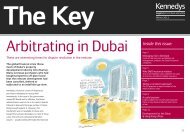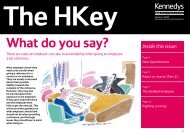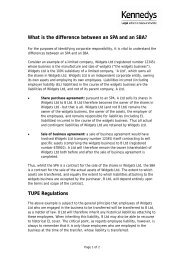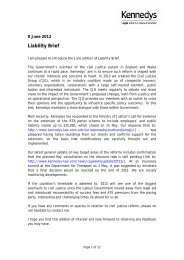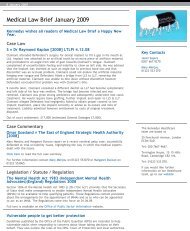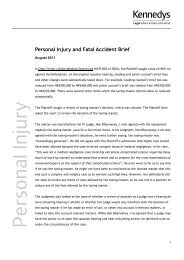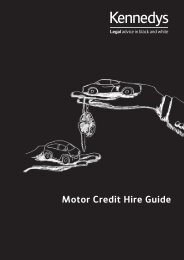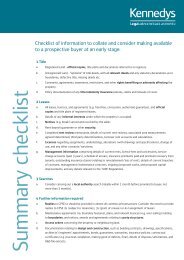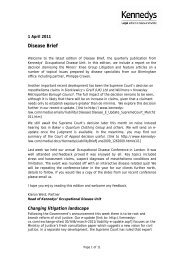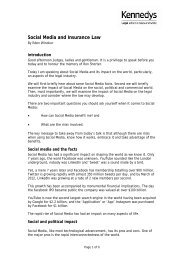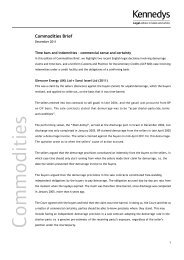Download Medical Law Brief - February 2013 (PDF ... - Kennedys
Download Medical Law Brief - February 2013 (PDF ... - Kennedys
Download Medical Law Brief - February 2013 (PDF ... - Kennedys
You also want an ePaper? Increase the reach of your titles
YUMPU automatically turns print PDFs into web optimized ePapers that Google loves.
<strong>February</strong> <strong>2013</strong><br />
<strong>Medical</strong> <strong>Law</strong> <strong>Brief</strong><br />
Welcome to the <strong>Medical</strong> law <strong>Brief</strong>.<br />
The Ministry of Justice has published its consultation into the legal framework for<br />
setting the personal injury discount rate. The consultation seeks views on two<br />
issues: whether the legal parameters defining how the rate is set should be<br />
changed and whether there is a case for encouraging the use of periodical payment<br />
orders instead of lump sum payments. It follows the earlier consultation that<br />
closed in October 2012 on the methodology to be used in setting the personal<br />
injury discount rate. The consultation is open until 7 May <strong>2013</strong>. Keep up to date<br />
with progress of the discount rate with our dedicated webpage<br />
http://www.kennedys-law.com/discountrate/<br />
The Civil Procedure Rule (CPR) Committee has finally released the changes to<br />
practice directions that support the 60th update to the CPR, which come into force<br />
on 1 April <strong>2013</strong>. There will be a further statutory instrument and practice<br />
direction document with amendments next month. At the same time, there is<br />
growing concern about the apparent defects in the rules published with regard to<br />
new funding arrangements. The Bar Council has argued that the rules as currently<br />
drafted are “not fit for purpose” and undermine the intentions of Lord Justice<br />
Jackson. These issues were debated in the House of Lords on 26 <strong>February</strong> <strong>2013</strong> but<br />
the Government has confirmed there will be no delay in implementing the reforms.<br />
The Government has launched a consultation on proposals to make it mandatory<br />
for all regulated healthcare professionals to hold indemnity or insurance to<br />
practice. The proposals aim to address the current inconsistency in the statutory<br />
healthcare professional regulatory bodies in relation to legislation or guidance on<br />
the need to hold such cover. The consultation will run until 17 May <strong>2013</strong>.<br />
The Government also proposes to amend medical regulations from April <strong>2013</strong> to<br />
appoint up to 220 senior doctors as the “responsible officer” in clinical<br />
commissioning groups set up to check the language and communications skills of EU<br />
doctors as well as their credentials.<br />
Finally, the Court of Protection has ruled that it would be disproportionate and<br />
unnecessary to perform a sterilisation procedure on a 21 year old woman with<br />
Down's Syndrome. Whilst her parents had requested the procedure for the woman's<br />
own protection, the judge noted that the woman was well supervised and said that<br />
the potential complications of sterilisation needed to be borne in mind.<br />
As always, I hope you enjoy reading this edition and welcome your feedback.<br />
Janet Sayers, Partner<br />
Liability Division<br />
Page 1 of 9
Case reviews<br />
Cerebral palsy: Court of Appeal reviews negligence finding<br />
Court of Appeal upholds decision that Claimant’s cerebral palsy caused by<br />
negligent failure to spot signs of fetal distress and expedite delivery - Popple v<br />
Birmingham Women’s NHS Foundation Trust [11.12.12].<br />
Comment<br />
Birth injury cases predominantly centre around alleged failures in management<br />
during the first and second stages of labour. The importance of taking time to<br />
consider whether it is clinically appropriate to continuously monitor by way of CTG<br />
both at the outset of contractions, during established labour, and during the active<br />
stage of delivery cannot be overemphasised.<br />
This was a case in which it was noted that continuous monitoring had not been in<br />
place from 14:00 hours and there had been suspicion of fetal distress at that time.<br />
Such monitoring may assist midwives when making a judgement as to whether or<br />
not to act swiftly to avoid fetal hypoxia and facilitate earlier delivery. In this case<br />
damage could have been avoided if delivery had taken place only five minutes<br />
earlier.<br />
However, even when continuous CTG monitoring is put in place, it should not<br />
become a substitute for careful observation and auscultation by a trained midwife<br />
with clinical experience.<br />
The ability to correctly interpret a CTG trace is essential in both isolating fetal<br />
hypoxia and ascertaining when a trace should not cause concern. Care must be<br />
taken to avoid unnecessary caesarean sections through an overreliance upon<br />
continuous monitoring. Such monitoring cannot replace an experienced midwife<br />
who is able to understand the whole clinical picture.<br />
Background<br />
The detailed background to this case can be seen in our case review of the High<br />
Court decision from January 2012.<br />
In summary, the Claimant suffered brain damage at birth resulting in severe<br />
cerebral palsy. After a nine day trial in the High Court, His Honour Judge Oliver<br />
Jones QC held the Defendant liable. Subject to the Court’s approval, damages had<br />
been agreed at £5.5m. Partly because so much was at stake both for the NHS and<br />
for the Claimant, permission was given to appeal, on fact only.<br />
Page 2 of 9
Decision<br />
The leading judgment was given by Lord Justice Ward. He considered the key issues<br />
and dismissed the appeal:<br />
<br />
<br />
<br />
<br />
What was the cause of the injury? This was not in dispute. Compression<br />
or occlusion of the umbilical cord had caused an asphyxial insult leading to<br />
circulatory collapse for a period of 15 to 20 minutes.<br />
When did the injury occur? The issue was whether the injury had<br />
occurred in the immediate run up to delivery, as the Judge had found, or<br />
at some considerable time before birth, as the Defendant contended.<br />
There was ample evidence for the Judge to have come to the conclusion<br />
he did. The clinical view of the experts was that the trace for the period<br />
immediately before the Claimant’s birth was uninterpretable, therefore it<br />
was unreliable. Consequently it could not displace the overwhelming view<br />
of the causation experts that the Claimant suffered his injury immediately<br />
before birth.<br />
Should the Claimant have been born before the injury occurred? In light<br />
of the evidence, the latest time for safe delivery was 14:44 hours on 21<br />
September 1997, five minutes before the actual delivery time. The Judge<br />
was entitled to find on the evidence that the midwives should have called<br />
for assistance or performed an episiotomy to allow for delivery as early as<br />
14:20 hours and in any event within one or two contractions after 14:30<br />
hours.<br />
Were the midwives in breach of their duty to take proper care in the<br />
management of his mother’s labour? There was no appeal against the<br />
Judge’s findings of breach of duty. The period of profound bradycardia for<br />
a period of 15 to 20 minutes before birth was either not detected or was<br />
ignored by the midwives because of a complete failure properly to monitor<br />
his heart rate.<br />
Find out more<br />
A midwife's duty: expected skills - http://www.kennedyslaw.com/casereview/midwifesdutyexpectedskills/<br />
For more information please contact Ed Glasgow – e.glasgow@kennedys-law.com.<br />
CT scanning/improved healthcare - http://www.kennedyslaw.com/article/ctgscanningimprovedhealthcare/<br />
http://www.kennedyslaw.com/casereview/cerebralpalsycoareviewsnegligencefinding<br />
Page 3 of 9
Dentist: no delay in oral cancer referral<br />
High Court rejects claim that dentist should have made earlier referral for<br />
investigation of mouth lesion - Drabble v Hughes [23.01.13].<br />
Implications<br />
This case emphasises the need for rigorous note keeping by clinicians. Despite<br />
detailed records maintained by the dentist in question he was still required to<br />
defend his actions at a High Court hearing. His expert evidence was that the<br />
presence of the cancer would not have been detectable with the human eye at the<br />
time alleged as its presence would have been at a cellular level only.<br />
To afford greater protection in such cases the dentist would be wise to seek<br />
completion of a signed pre-admission checklist by the patient. This should include<br />
questions as to whether the patient has any new developments or concerns<br />
regarding their oral health.<br />
Background<br />
The Claimant sought damages against the Defendant, her dentist, in respect of his<br />
alleged failure to refer her for investigation of a lesion in her mouth. From April<br />
1995 a white patch in her mouth was kept under observation at the University<br />
Dental Hospital, Manchester. She was discharged from the hospital in October 2004<br />
on the basis that in future she could be reviewed at routine dental check ups.<br />
The Claimant alleged that she should have been referred urgently following an<br />
examination by the Defendant on 30 June 2008. She was in fact referred to hospital<br />
by him in April 2009 on a non-urgent basis. Following investigation she underwent<br />
surgery in July 2009 to remove a tumour in her mouth extending into the lymph<br />
nodes. After a protracted course of treatment, and despite an initially poor<br />
prognosis, the Claimant made a good recovery. She was left with a number of<br />
permanent functional problems.<br />
It was common ground that had malignant changes been present in June 2008 then<br />
earlier referral and treatment would have meant that less invasive and radical<br />
treatment would have been required.<br />
Decision<br />
Mr Recorder Sweeting QC dismissed the Claimant’s claim:<br />
<br />
<br />
The case turned on issues of fact which arose, essentially, from the<br />
conflicting evidence of the Claimant and Defendant.<br />
If the Claimant was correct in her contentions, the Defendant not only<br />
failed to observe the change in the appearance of the white patch in June<br />
Page 4 of 9
2008 but also failed to record her complaints that such a change had<br />
occurred. These errors and omissions would then necessarily have been<br />
repeated to a greater or lesser extent on each of the four further<br />
occasions on which he saw her in 2008 and 2009.<br />
<br />
The improbability of this persistent failure led him to reject the<br />
Claimant’s account and to prefer that of the Defendant.<br />
For more information please contact Tom Armstrong – t.armstrong@kennedys-lawlaw.com.<br />
http://www.kennedys-law.com/casereview/dentistnodelayinoralcancerreferral<br />
Future loss of earnings: lack of evidence<br />
Court of Appeal upholds lump sum Blamire award; Claimant had failed to<br />
demonstrate she would suffer a loss of earnings as a result of the accident -<br />
Ward v Allies and Morrison Architects [10.10.12]<br />
Background<br />
The Claimant who had a first class honours degree in model making for design and<br />
media was working as a model maker on a short term placement at the<br />
Defendant’s offices. She was asked to cut some wood using an unguarded circular<br />
saw. Whilst doing so, the index finger of her left (non-dominant) hand was cut off<br />
and her middle finger was significantly damaged by dislocation. Fortunately her<br />
index finger was reattached and she made a considerable recovery although the<br />
extent of it was in issue at trial.<br />
At first instance, His Honour Judge Cleary held that the injury to her index finger<br />
was an inconvenience rather than a disability, and its cosmetic impact was<br />
negligible. Her difficulty in finding work was because she had been out of<br />
circulation for a period of four years, in an industry in which it was difficult to get<br />
started unless doors were opened, contacts “engaged” and in which tenacity and<br />
bloody-mindedness were required in order to succeed.<br />
The key issue on appeal concerned the basis on which the Judge had awarded<br />
damages for loss of future earnings. Having concluded that as a matter of both fact<br />
and law she was not a “disabled person”, he held that this should be on a “broad<br />
brush” basis, following the decision in Blamire v South Cumbria Health Authority<br />
[1993]. This was in preference to the conventional multiplicand/multiplier<br />
approach which would have resulted in a much higher award than the £30,000<br />
awarded, which was to allow the Claimant to retrain if she chose to do so.<br />
Decision<br />
The Court of Appeal upheld the first instance decision:<br />
Page 5 of 9
The multiplicand/multiplier methodology and the tables and guidance in<br />
the current edition of Ogden should normally be applied when assessing<br />
future loss of earnings, unless the judge really has no alternative.<br />
In order to carry out the conventional exercise, a judge has to make<br />
findings on the likely pattern of the claimant’s future earnings, both had<br />
they not been injured, and given that they had been injured, the burden<br />
of proof resting on the claimant.<br />
In this case, the Judge was not satisfied that the Claimant had<br />
demonstrated that she would actually suffer a loss of earnings as a result<br />
of the accident. Given the many imponderables he was driven to adopt the<br />
Blamire approach.<br />
Even if the Blamire approach had been incorrect in principle, the disability<br />
factor in Ogden 6 could not have been used in this case. Considering the<br />
wording in paragraph 35 of the introduction to Ogden 6, the third<br />
condition, “their condition affects either the kind or the amount of paid<br />
work they can do”, had not been satisfied.<br />
Implications<br />
The original injury to the Claimant was significant, and a sizeable award for future<br />
loss of earnings might have been expected. The decision however serves as a<br />
reminder that a claimant has to prove that they will suffer an actual loss. In this<br />
case, the Claimant failed to prove that the injury would lead to a loss of earnings.<br />
She was perhaps fortunate that the Judge went so far as to make a Blamire award<br />
of £30,000.<br />
Whilst a conventional loss of earnings award was not made in this case, the case<br />
also serves as a reminder of the conditions that must be met for a claimant to be<br />
regarded as disabled for the purposes of a calculation using the Ogden tables. It is<br />
reassuring to see the Court of Appeal adopting a strict approach in this regard,<br />
confirming that the disability factor in Ogden 6 could not have been used in this<br />
case, even though the Claimant sustained a serious hand injury.<br />
For more information please contact Richard McKeown – r.mckeown@kennedyslaw.com.<br />
http://www.kennedys-law.com/casereview/futurelossofearningslackofevidence/<br />
Page 6 of 9
Feature article<br />
No-fault compensation scheme for Scotland<br />
The Scottish Government has consulted on a no-fault compensation scheme for<br />
injuries resulting from clinical treatment. We consider the proposals and issues of<br />
concern.<br />
Overview<br />
The consultation, which was launched on 20 August 2012, followed a review by a<br />
group of independent experts led by Professor Sheila McLean. The group reviewed<br />
the current no-fault compensation schemes in a number of countries including<br />
Sweden, Finland, Norway and New Zealand. It concluded that consideration should<br />
be given to introducing in Scotland a scheme similar to the Swedish model. The<br />
consultation process closed on 23 November 2012. We await the outcome of the<br />
consultation.<br />
The Scottish government’s final decision requires careful analysis of costs/benefits.<br />
Further detailed consideration is required. In view of the potential drawbacks, it<br />
may only be adopted on a pilot basis initially. Only then can we measure its<br />
impact. For the time being, the overall impression is that it would not be viable in<br />
the long term.<br />
Purpose of the scheme<br />
The scheme would allow patients who have suffered injury, loss or damage as a<br />
result of their medical treatment to receive compensation without having to<br />
establish breach of duty. This should avoid litigation and, in theory, promote a<br />
system where more people could obtain compensation on a quicker and more costeffective<br />
basis, thereby reducing spiralling legal costs.<br />
However, the scheme would still require causation to be proved and quantum to be<br />
established. This could result in satellite litigation. It is contended by the<br />
Association of Personal Injury <strong>Law</strong>yers (APIL) that patients cannot be left to deal<br />
with causation and quantum without the benefit of legal expertise. Consequently,<br />
legal costs would continue to be incurred. Otherwise, APIL consider that there is a<br />
serious risk that victims of clinical negligence will be undercompensated.<br />
It would be open to patients to pursue litigation to seek additional compensation,<br />
albeit any no-fault award would be deducted from any damages received through<br />
litigation. It follows that patients who pursue litigation will also be able to apply<br />
under the scheme.<br />
Extent of the scheme<br />
Page 7 of 9
It is intended that the scheme should cover all healthcare services and not only the<br />
NHS. This would include private healthcare sector hospitals and clinics and<br />
independent practitioners.<br />
Paying for the scheme<br />
It has been suggested in the Scottish press that their Government considers that<br />
the scheme could be run for the same costs as the NHS currently pay for<br />
compensation and legal fees. This would be a cost neutral scheme. However,<br />
compensation would need to be paid in conjunction with guarantees of appropriate<br />
welfare provision. This would see patients receiving less in overall monetary<br />
awards, as is the experience in Sweden and other schemes around the world.<br />
The funding and costs of the scheme is queried by APIL and the Forum of Insurance<br />
<strong>Law</strong>yers (FOIL). According to APIL, the current costs estimate of the scheme was<br />
based on NHS claims alone and did not take into account private healthcare claims.<br />
In addition, there has been an apparent failure to acknowledge a potentially<br />
significant increase in claims if negligence does not need to be proved. As the<br />
claim numbers increase, so would the previously estimated amount of damages due<br />
to be paid. This may therefore result in some form of compulsory insurance to pay<br />
for the costs shortfall in running the scheme. Such insurance is found in most of the<br />
Scandinavian countries.<br />
Issues of concern<br />
The introduction of the scheme in Scotland may be problematic. Commentators<br />
have raised various concerns, including the following:<br />
<br />
<br />
<br />
A causal link still needs to be proved between the treatment and the<br />
resultant injury. Quantification of the claim also needs to be established.<br />
Causation and quantification require expert and legal involvement. This<br />
would result in costs being incurred and a delay in resolution of claims.<br />
There would be satellite litigation arising from disputes in the scheme in<br />
terms of applicability, causation and quantum.<br />
The right to litigate will remain. Patients who consider they are<br />
undercompensated may attempt to top up with litigated damages. This<br />
would not avoid litigation or associated costs.<br />
Compensation under the scheme would be lower than in a normal claim for<br />
damages. This is on the basis that any scheme would need to cap the<br />
damages provided, in order to be sustainable. It is likely that patients<br />
would not be satisfied in high value claims where the welfare system<br />
cannot sufficiently meet their needs in conjunction with any reduced<br />
damages.<br />
Page 8 of 9
The removal of threatened litigation may reduce the incentive to seek<br />
higher standards of care within the NHS and the healthcare industry<br />
generally.<br />
Compensation when breach of duty does not need to be proved may<br />
replace an explanation or apology to patients in respect of their care. This<br />
could result in a lack of accountability.<br />
The affordability of the scheme does not appear to be fully realised at this<br />
stage.<br />
For more information please contact Nico Fabri – n.fabri@kennedys-law.com.<br />
http://www.kennedyslaw.com/casereview/cerebralpalsycoareviewsnegligencefinding<br />
<strong>Kennedys</strong> is a trading name of <strong>Kennedys</strong> <strong>Law</strong> LLP. <strong>Kennedys</strong> <strong>Law</strong> LLP is a limited liability partnership<br />
registered in England and Wales (with registered number OC353214).<br />
Page 9 of 9



